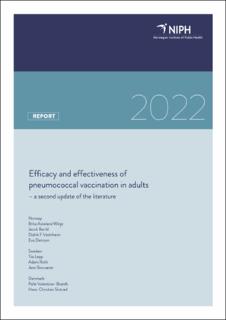Efficacy and effectiveness of pneumococcal vaccination in adults – a second update of the literature. The review is a collaboration between Public Health Institutes in Norway, Sweden and Denmark
Askeland Winje, Brita; Berild, Jacob Dag; Vestrheim, Didrik Frimann; Denison, Eva Marie-Louise; Lepp, Tiia; Roth, Adam; Storsæter, Jann; Valentiner-Branth, Palle; Slotved, Hans-Christian
Research report
Published version
Permanent lenke
https://hdl.handle.net/11250/2996316Utgivelsesdato
2022Metadata
Vis full innførselSamlinger
Sammendrag
Introduction
Young children, elderly and persons with weakened immune systems are at high risk of acquiring invasive pneumococcal disease and pneumococcal pneumonia. Two different vaccines have been used for the prevention of pneumococcal disease in adults: a 23-valent polysaccharide vaccine (PPV23), and a 13-valent conjugated vaccine (PCV13). New higher-valency pneumococcal conjugate vaccines have been licensed for use in adults 18 years or older based on immunogenicity data. No clinical effectiveness data are so far available, and these vaccines are not part of this report.
Methods
The report covers publications on PCV13 and PPV23 efficacy and effectiveness from 2000 until February 2021 from randomized controlled trials and observational studies. Outcomes include invasive pneumococcal disease and pneumococcal pneumonia.
Results
A total of 32 publications are included: 22 publications on PPV23 effectiveness, nine publications on PCV13 effectiveness and one publication reporting PPV23 and PCV13 effectiveness. No study compared the effectiveness of PPV23 and PCV13 head-to-head. One large trial with overall healthy elderly dominates the evidence for PCV13 efficacy and effectiveness. The evidence for PPV23 vaccine effectiveness, on the other hand, is based on trials of moderate quality and several observational studies. Differences in populations, study designs and time since vaccination makes it difficult to summarize available evidence into single quantitative measures.
The vaccine effectiveness of PPV23 in preventing invasive pneumococcal disease was consistent with past systematic reviews and similar to the estimates that have been reported for PCV13 efficacy and effectiveness. Consistent effects were reported across observational studies and ecological studies of surveillance data for the general elderly population. PCV13 seems to provide better protection than PPV23 against vaccine-type invasive pneumococcal disease (for serotypes common to PCV13 and PPV23).
We found both PPV23 and PCV13 to be effective in preventing pneumococcal pneumonia in elderly at comparable levels. The PPV23 vaccine effectiveness was higher in clinical trials than observational studies, possibly reflecting a shorter follow-up time and a more limited impact of waning immunity. Both PPV23 and PCV13 showed generally lower effectiveness with increasing age for all outcomes and in groups with immunocompromising conditions. Overall, significant VE was not shown for immunocompromised groups.
Conclusion
This report shows that both PCV13 and PPV23 provide prevention for invasive disease and pneumococcal pneumonia in the elderly. The overall body of evidence shows PPV23 effectiveness at a level comparable to PCV13. This finding is of paramount importance for public health due to the high pneumococcal pneumonia disease burden. The serotype distribution in carriage and disease is important to consider for the impact of vaccination. The currently low proportion of patients falling ill with serotypes included in PCV13 suggests limited potential for prevention from adult PCV13 vaccination. Well-designed and serotype specific randomized controlled trials are important to improve evidence.
